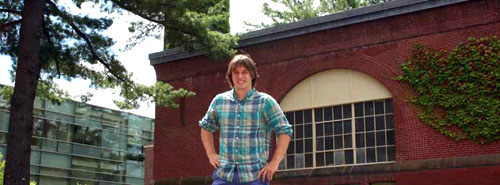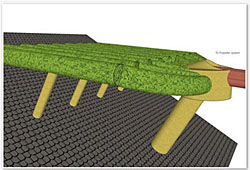
Keith Heyde ’11 is developing a prototype waste-to-energy system that would use boiler exhaust as food for energy-producing algae.
Keith Heyde ’11 doesn’t want to get his innovative algae-to-energy project off the ground. He wants to get it on the roof.
A student in Bowdoin College’s 3-2 engineering option with Columbia University, he is developing a filtration system that would harness emissions of household CO2 to turn waste to energy.
Heyde is developing a prototype biomass system that attaches to a residential chimney and uses boiler exhaust as food for energy-producing algae. It’s not as far-fetched as sounds. Algae feed on carbon dioxide, converting CO2 into organic carbon. Dried, the algae can be converted into a diesel-like biofuel-or even become a feedstock for hydrogen-producing bacterium, a basis for hydrogen fuel cells.Energy experts and oil companies alike have been experimenting with algae-energy production for a number of years, but efforts have been criticized as cost-prohibitive and energy inefficient.”
I’ve talked to researchers who say this kind of waste-to-energy is not viable,” notes Heyde’s research mentor, Bowdoin biomathematician Professor Mary Lou Zeeman. “Because you have to dry the algae before feeding it to bacteria, it is apparently too energy intensive in most circumstances.”
Heyde’s idea puts a smaller, more manageable spin on it, says Zeeman: “It’s quite different if you think of it at the residential level. You don’t need huge drying units, you could possibly do it from sunlight.
“I think Keith is a very courageous guy who’s not afraid of trying to make things work,” says Zeeman.
The basic mechanics he proposes are fairly simple: A wind-powered propeller would draw exhaust gas up from the chimney and into a network of pipes filled with seawater and marine algae.
“Using photosynthesis, the algae will feed off the boiler exhaust bubbling through the water,” says Heyde. “What it shoots out is less polluted effluent.”The algae contained in the piping would be regularly harvested and dried for biofuel or put into fermentation tanks with hydrogen-gas producing bacteria.If the basic mechanics of Heyde’s filtration system are straightforward-at least in theory-the environmental calculations required to get optimal results are not.
Over the summer, Heyde conducted rigorous experiments in Zeeman’s lab on several algae, measuring how their population dynamics were affected by constraints such as light, gas residence time and nutrient loadings. The results help describe how efficient these species are at absorbing carbon and under what conditions.
From these data, he hopes to derive a differential equation that could help project models of efficiency for algae filtration systems.
“This is cool stuff,” says Heyde. “My idea is to hopefully create something that is very low-cost, relatively low-tech, that an environmentally conscious homeowner could work with.
“Whether or not Heyde’s differential equation translates to a rooftop rig, Zeeman says his research is forward-thinking:”It’s an area that hasn’t been thoroughly explored yet,” says Zeeman. “Keith may be looking pretty far into the future, but he’s smart, he’s done his background research, and he’s adding important basic knowledge to the field.
“Heyde’s algal research was supported by a grant from the Hughes Family Summer Research Fellowship in Environmental Studies.
